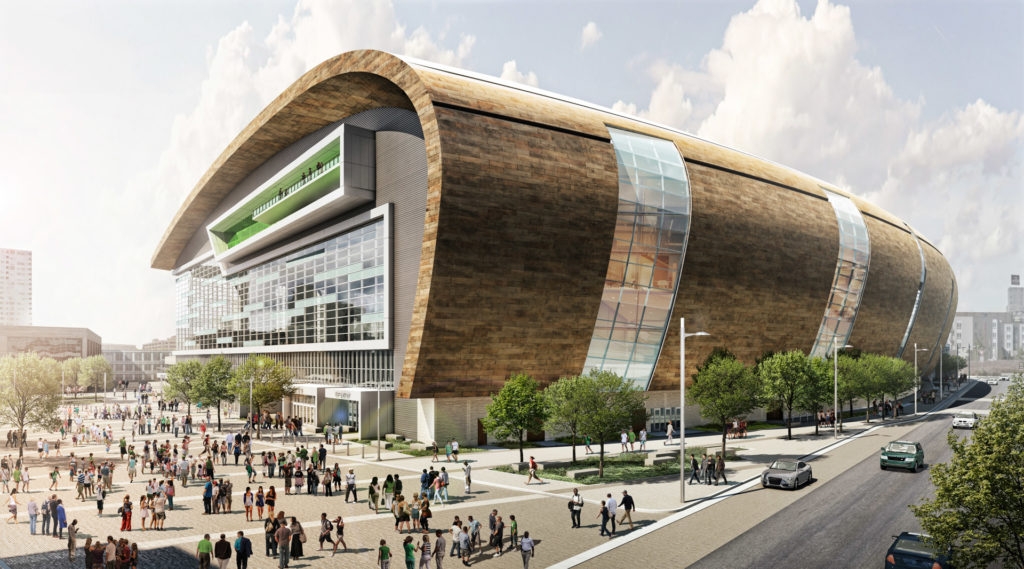
MILWAUKEE — Construction vehicles and dusty streets surround the Milwaukee Bucks’ new downtown arena that is less than a year away from completion.
The state-of-the-art facility will be the Bucks’ home starting in 2018. But in many respects the massive project is more than just about basketball.
Team and arena executives want to get major entertainment acts to stop in Milwaukee. They want the arena to be a driver for ambitious downtown redevelopment.
And to do that, they have to go out to market and sell Milwaukee.
“We want to create an international destination with talent. We want to compete with every major city, we want to be on every tour stop,” team president Peter Feigin said. “We have this one window of time to tell our story and our narrative around the world.”
That is exactly what Feigin, along with team and arena officials, planned to do this week in London. They were meeting with concert promoters and artist management firms in hopes of bringing major international acts to Milwaukee.
The groundwork was laid in part when the Bucks named Raj Saha as general manager of the Wisconsin Entertainment & Sports Center. He managed the O2 arena in London for arena giant AEG, and also helped stage the 2012 London Olympics and 2014 World Cup in Brazil.
The Bucks view the $524 million arena project, which was partially financed by public funding, as a centerpiece of downtown revitalization. The facility will replace the 30 year-old BMO Harris Bradley Center, which sits next to the project.
While the Bradley Center did draw its share of major acts, Feigin and Saha said there were limitations to the aging arena.
The steel trusses and infrastructure at the new arena have been built to carry and support the weight needed for the elaborate-style productions used in major concerts, Feigin said. The arena has 200,000 pounds of rigging capability, according to the Bucks.
With a seating capacity of 17,500 for basketball and 500 more for concerts, the arena has 10,000 seats in the lower bowl, which planners say will help audio-visual experiences. Two-thirds of the seats in the Bradley Center are in the upper level.
And Feigin says that the Bucks have placed a premium on acoustics, including a roof designed to lower reverberation and reduce echoes. The arena also has what’s called “specialized low frequency absorption” for bass notes allowing for cleaner bass sound.
“It’s secondarily about basketball, probably the only thing that’s secondarily about basketball is how you design this so it’s a surreal acoustic experience, as well as a visual experience,” Feigin said.
In Saha’s experience, only a handful of U.S. arena executive have traveled to London to talk to promoters. Consider this trip another way in which the Bucks, who have New York-based ownership, are thinking big.
The area already has a reputation as a music destination with Milwaukee’s Summerferst music festival. The demographics are different in Milwaukee from Chicago and Minneapolis, Saha said.
The first new sign of how things are changing popped up this summer. The Bucks moved into a new, state-of-the-art practice facility downtown, across the street from the arena construction site.
“It’s amazing. It’s refreshing to walk in here every day,” guard Malcolm Brogdon said after the first practice last week. “Everything in here is just made to perfection.”
The facility and new arena give the Bucks two new draws with which to attract or retain players in the future. With the young team itself on the rise after two playoff appearances in three seasons, Milwaukee’s image as an NBA outpost is starting to disappear.
Similarly, the Bucks see the new arena as an avenue to open new inroads into Milwaukee, music and otherwise.
“We don’t think there’s any reason why — especially logistically, geographically, monetarily — we (couldn’t) get the music acts. Part of the reason we haven’t is because we haven’t been out there to tell our story, to market, to sell,” Feigin said. “That’s really what we’re doing.”
___
More AP NBA: apnews.com/tag/NBAbasketball










